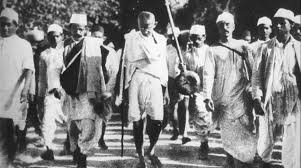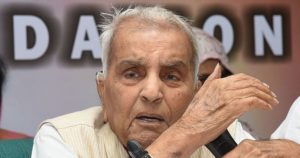Prem Singh
9 August 2019 is the 77th anniversary of the Quit India Movement, famously known as the August Revolution and an important milestone in the history of India’s freedom movement. As per a letter written by Dr. Ram Manohar Lohia to the Viceroy Linlithgow, the British government had killed fifty thousand patriots and injured many times more people during the August Revolution.
The 75th anniversary of this movement, a movement which was fuelled by the intense desire for freedom of the Indian people, was celebrated two years ago on 9 August 2017. On that occasion, Prime Minister Narendra Modi gave a call for the revival of the spirit of the Quit India Movement by coining a new slogan karenge aur karke rahenge in place of Gandhi’s slogan karo ya maro (Do or Die). The slogan is a sort of exhortation to achieve the goal of building a “New India” by the year 2022. He said that India will complete 75 years of Independence in 2022 and the memory of the 75th anniversary of the Quit India Movement should be utilised by striving for the creation of a New India so that the vision can be realised by the 75th anniversary of Independence.
The Prime Minister’s call is utterly misaligned with the basic spirit which underlay the Quit India movement. Because it is hard to link this spirit with the idea that lies behind Prime Minister’s New India. This New India is being built at the cost of the Constitution, the sovereignty and the resources of our country. And yet the Prime Minister is giving the call to harness the spirit of the struggle for Independence, including the Quit India Movement, for building such a New India. This can only be possible when the spirit of freedom is reduced to the spirit of slavery.
In this article, the spirit of freedom which inspired the people of India during the Quit India Movement, has been contemplated with reference to Lohia’s analysis of the same. Lohia uses the phrase “will of freedom” instead of spirit of freedom in his analysis.
In the Indian freedom struggle, the will of freedom and the strength, gathered from various sources, to achieve independence finally culminated in the Quit India Movement. The Quit India Movement conveyed the fact that even if the leaders of the country were directed by the will of freedom, the real strength to achieve it decisively resided in the people. In this nationwide movement, a very large number of people participated and the movement witnessed unprecedented courage and endurance. Lohia has written, quoting a figure given Leon Trotsky, “barely one percent of the Russian population took part in the Russian Revolution. In our Revolution no less than 20% of our people took part.” (Collected Works of Dr. Ram Mannohar Lohia, Volume 9, p. 129, Anamika Publishers, Delhi, 2011)
The “Quit India” resolution was passed on August 8, 1942; Aruna Asaf Ali hoisted the tricolor on the Gowalia Tank ground; and on the night of 9th August, the senior leaders of the Congress were arrested. Due to the arrest of the leaders, the action plan of the movement could not be formulated. The relatively young leadership of the Congress Socialist Party (CSP) was active, but it had to work underground. In such a situation, Jaiprakash Narayan (JP) wrote two long letters from unknown places to provide the guidance and encouragement to the revolutionaries and to explain the character and method of the movement. It can be said that the public itself was its leader during the Quit India Movement.
Lohia wrote on the twenty-fifth anniversary of the Quit India Movement, “9th August was and will remain a people’s event. 15th August was a state event. . . . 9th August 1942 expressed the will of the people—we want to be free, and we shall be free. For the first timer after a long period in our history, crores of people expressed their desire to be free. . . . Anyhow, this is the 25th anniversary of 9th August 1942. It should be celebrated well. Its 50th anniversary perhaps will be celebrated in such a way that 15th August will be forgotten, and even 26th of January will either be foreshadowed or would equal it.” (Note and Comments, Vol. II, Ram Mannohar Lohia, p. 221, Ram Mannohar Lohia Samata Vidyalaya Nyas, Sultan Bazar, Hyderabad, 1975)
Lohia did not live to see the fiftieth anniversary of the August Revolution. His belief that people will listen to him after his death has been proven to be a delusion. The fiftieth anniversary of the August Revolution came in the wake of New Economic Policies which had been introduced in the year 1991. These policies had opened the country’s doors to the domestic and foreign multinationals for loot; and a five hundred years old mosque was demolished in the name of Lord Rama. Since then, due to the nexus of neo-liberalism and communalism, the ruling class of India has become the bitter enemy of the Indian people, who had paved way for freedom while facing the suppression of imperialist rulers in the Quit India Movement.
The inception of PM’s much glorified New India took place in 1991. In the last three decades, the sovereignty and resources have been snatched from the country, and the constitutional rights have been snatched from the people. The spirit of the freedom struggle, including that of the Quit India Movement, is being used by its propagators to try and build this New India, which basically means a new kind of slavery, to foreign corporations and their governments. If we have to stop this future from becoming a reality, a new resolution must be taken by borrowing the words of Lohia—“we want to be free, and we shall be free” from New India. Further taking clue from Lohia’s perception about the spirit of the Quit India Movement, it can be said that this revolution to regain India will be brought to life by the people of India as they did on August 9, 1942.
(The writer teaches Hindi at Delhi University.)




